|
The pictures are arranged
by Family.
Return to
Native Plants page. |
__________________________________________________________________________________________________
TREES |
|
FABACEAE - Legume Family |
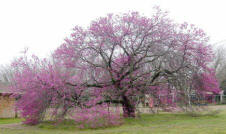
(Photo by Melanie Migura)
Texas redbud - Cercis canadensis var. texensis
This pictured Texas Redbud variety is a regional champion tree. It is more
drought tolerant than its relative, the Eastern Redbud. It grows
on limestone soils & has the same beautiful spring blooms. It is a
great small tree to plant as an accent or centerpiece and its size
makes it a choice candidate for planting under powerlines. |
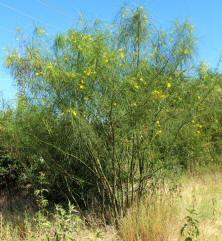
Paloverde - Parkinsonia aculeata
Paloverde is a native of the Lower Rio Grande Valley & Mexico but it has
naturalized in north Texas in some areas where it has escaped from
cultivation. It has green bark & twigs, which help it
photosynthesize after dropping its leaves during drought conditions.
The yellow flowers add a whisy delicate look. The Paloverde also
has thorns so if you use this small tree in your landscape, make sure it
is away from well-traveled areas of your yard.
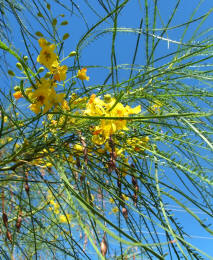 |
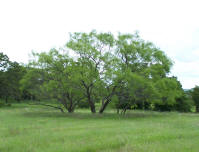
Mesquite - Prosopis glandulosa
Honey Mesquite is a common tree in our area. It tends to invade
pastures & grasslands that are unbalanced. It is a very
drought-tolerant tree that makes a nice addition to an urban landscape -
especially xeriscapes - but watch out for the thorns! Don't plant
a mesquite near a water line or septic system because these trees have
infamous water-seeking roots - which is what makes them so hardy even in
the worst of droughts. |
FAGACEAE - Oak Family |
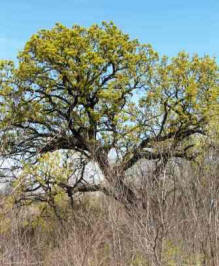
Bur oak - Quercus macrocarpa
The Bur oak grows to towering heights. You could think of it as
representing Texas where "everything's bigger in Texas" because the tree
is big, the leaves are big, & the acorns are big! Large acorns
give it the scientific species name of macrocarpa, which means
"big fruit." This tree provides deep shade so plant one now so you
& your family will still be able to enjoy its cooling effects & majesty. |
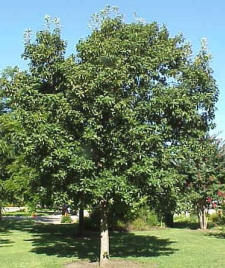
Chinquapin oak - Quercus
muehlenbergii
This is not a Chinquapin tree, but rather an oak that has leaves similar
to the Chinquapin, hence its name Chinquapin oak. This oak grows
in uplands & creek bottoms on calcareous/limestone soils. It is a
popular landscaping tree in our area. It has an interesting leaf
shape & displays beautiful fall colors.

|
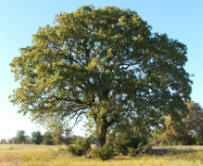
Post
oak - Quercus stellata
Post oak has a beautiful branching structure that speaks to rugged
determination and strength. The silhouette of this tree is almost
iconic. They grow mostly in sandy soils and are the dominant
species of the Cross Timbers ecosystem. If you have Post oak on
your property & you are considering removing some; think long & hard
about this because these beautiful trees cannot be replaced in your
lifetime. Post oaks are not often found at nurseries so if you
have the chance to plant one on your property, don't pass up the
occasion! |

Shumard red oak - Quercus
shumardii
This fast growing oak is a popular choice with homeowners. It
provides quick shade & excellent fall color. Its shape is very
attractive as well. It's susceptible to Oak Wilt, so before
selecting a Red oak, check the diversity of trees in your yard &
neighborhood. You don't want to get completely wiped out if Oak
Wilt strikes your area. Shumard red oaks grow naturally along
streams & in moist forests. However, they do excellent in
landscape settings.
|
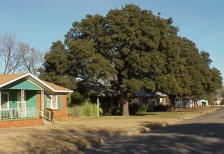
Live oak - Quercus virginiana
Live oaks illicit an image of the 'Deep South' & tree-lined streets with
Spanish moss dangling from their limbs. Live oaks are stately
trees with spreading canopies that provide extensive shade. They
are popular landscaping trees in our area because they are
semi-evergreen; meaning they keep their leaves most of the year. |
|
JUGLANDACEAE - Walnut Family |
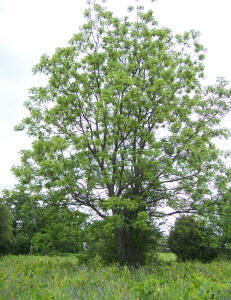
Pecan -
Carya illinoinensis
Pecan is Texas' state tree. It is a grand tree that grows
a large trunk, provides nutritious nuts & deep shade. Pecans grow
fairly rapidly & makes a nice landscape tree in a large yard or park.
Wildlife love the pecans. |
|
|
OLEACEAE - Olive Family |

Texas ash - Fraxinus texensis
This medium-sized tree grows on limestone soils. It is used in
landscaping situations. It is especially good for small
residential lots that do not have room for a large tree. Texas ash
is drought-tolerant & provides good fall color.
|
|
|
ROSACEAE - Rose Family |
|
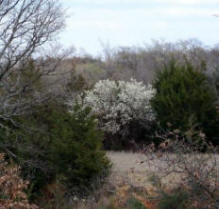
Mexican plum - Prunus
mexicana
This flowering tree is one of the first to bloom in the spring.
You can see it's white flowers in woods & thickets alongside the road as
you speed by. It grows in a variety of soils & does well as an
understory or full sun planting in a landscape situation. It
produces edible fruit, but just make sure to plant yours away from
sidewalks or patios - where the fruit might stain!
|
|
|
RUTACEAE - Citrus Family |
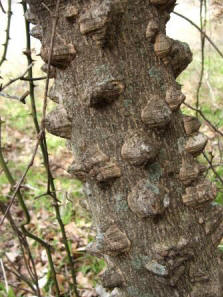
Hercules' club - Zanthoxylum
clava-herculis
This member of the Citrus family can be found in fields & other areas of
sandy or rocky ground. The bark is very interesting with its
knotty protuberances in pyramidal form. The odd-looking trunk
earns the tree its name. The leaves contain a compound that Native
Americans used to control pain. The leaves were chewed in order to
relieve toothaches & gum pain. Birds love to consume the fruit, &
thereby help distribute this tree.
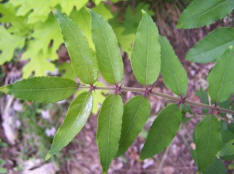
|
|
|
SAPINDACEAE - Soapberry Family |
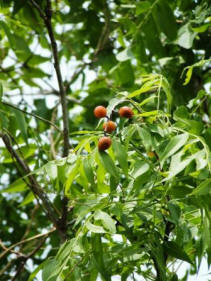
Western soapberry -
Sapindus saponaria var. drummondii
This tree is very drought resistant & has showy white clusters of
flowers in spring. In the fall, the leaves turn brilliant colors &
its amber fruits remain on the tree long after the leaves have fallen.
Soapberry gets its name because the berries were used by in the past as
a cleaning agent. If you place the mashed berries in a jar with
water & shake it, you will see how the name soapberry came to be.
The tree grows to about 30 feet & can be an excellent landscaping
choice, especially for small areas.
|
|
|
ULMACEAE - Elm Family |
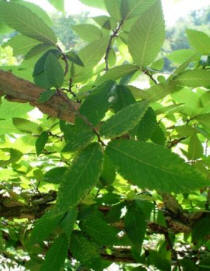
Winged elm - Ulmus alata
This small trees looks very "corky" when it is young. It grows in
sandy habitats in lowlands & uplands. In the past, the bark has
been used to make baling twine.
|
|
|
This listing of native
plants of the Cross Timbers eco-region is not comprehensive. This
is merely a compilation of some plants that can be found locally in
lawns, parks, development sites, and natural areas. If you keep
your eyes to the ground, you'll be surprised at what you might find!
With water conservation in our urban areas
becoming increasingly more important, native plants in our landscapes
can help us save our precious water. Native plants grow naturally
in our soils, climate & unpredictable weather. They are
drought-tolerant and need little attention. Some of these native
plants may not be available in most local nurseries, however, you might
try calling nurseries that specialize in native plants. You always
have the option of propagating these plants from seed or vegetatively.
If nothing else, knowing some native plants will help you appreciate
their role in our environment and urban settings.
Some good resources for ID & to learn
more about native plants of Texas are:
Shinners & Mahler's Illustrated Flora of North Central Texas
by George M. Diggs, Jr., Barney L. Lipscomb,
& Robert J. O'Kennon
Wildflowers of Texas by Geyata Ajilvsgi
Wildflowers of the Texas Hill Country by Marshall Enquist
Texas Wildflowers by Campbell & Lynn Loughmiller
Trees of North Texas by Robert A. Vines
Trees of Texas by Carmine Stahl & Ria McElvaney
Grasses of the Texas Hill Country by Brian & Shirley
Loflin
Common Texas Grasses: An Illustrated Guide by Frank W.
Gould
Texas Wildscapes: Gardening for Wildlife by
Noreen Damude and Kelly Conrad Bender
Landscaping with Native
Plants of Texas by George Oxford Miller
How to Grow Native Plants of Texas & the Southwest by Jill
Nokes
Find out how community volunteers can take
an area that was formerly neglected and overgrown with invasive, exotic
privet and return the site to the Eastern Cross Timbers ecosystem.
Visit the Molly
Hollar Wildscape website to learn more.
Return to Native
Plants page.
|